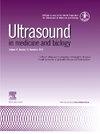Pilot Clinical and Radiomic Analysis of Deep Infiltrating Endometriosis of the Parametrium Using Shannon Entropy: A Retrospective Cohort Study
IF 2.4
3区 医学
Q2 ACOUSTICS
引用次数: 0
Abstract
Objective
Ultrasound techniques for diagnosing deep infiltrating endometriosis (DIE) currently lack a quantitative method to assess microstructural heterogeneity in relation to diagnosis and clinical symptoms. This study evaluates Shannon entropy–based radiomics for differentiating DIE lesions from adjacent tissue and correlating these features with pain severity.
Methods
In this retrospective cohort study (2020–2024), fertile women with histologically confirmed parametrial endometriosis and high-quality ultrasound images were evaluated. Pain was measured using a 10-cm visual analog scale. Two 25 mm² regions of interest (ROIs) were defined: one within the DIE nodule and one in the adjacent perilesional tissue. Each ROI was analyzed with the Shannon entropy algorithm to assess tissue heterogeneity.
Results
In this study, 148/663 women (22.3%) were diagnosed with parametrial DIE, of whom 52 underwent surgery and were included in the study. DIE was localized in 92.3% in the posterior, in 5.8% in both posterior and anterior, and in 2% in the anterior parametrium. Primary symptoms were menstrual pain (88%) and pain at intercourse (63%). ROI entropy of DIE lesion was lower than that of the perilesional ROI (p = 0.05). The area-under-the-curve (AUC) of Shannon entropy for endometriotic vs. adjacent tissue was 91.36% (95% CI: 84.5%–98.21%). The ROI entropy of the DIE lesion exhibited an inverse correlation with menstrual pain (rho −0.46, CI 95% −0.74/−0.12, p = 0.025), and that of perilesional tissue with chronic pelvic pain (rho −0.41, 95% CI −0.73/- 0.04; p = 0.072).
Conclusion
Entropy analysis distinguishes DIE lesion from perilesional tissue and significantly correlates with menstrual pain.
Shannon熵对深浸润性子宫内膜异位症的临床和放射组学分析:回顾性队列研究。
目的:超声技术诊断深浸润性子宫内膜异位症(DIE)目前缺乏定量的方法来评估与诊断和临床症状相关的显微结构异质性。本研究评估了基于Shannon熵的放射组学在区分DIE病变与邻近组织以及将这些特征与疼痛严重程度相关联方面的应用。方法:在这项回顾性队列研究(2020-2024)中,对组织学证实的子宫内膜异位症的有生育能力的妇女和高质量的超声图像进行评估。疼痛采用10厘米视觉模拟量表测量。定义了两个25 mm²的感兴趣区域(roi):一个在DIE结节内,一个在邻近的病灶周围组织。每个ROI用Shannon熵算法进行分析,评估组织异质性。结果:在本研究中,663名女性中有148人(22.3%)被诊断为参数性死亡,其中52人接受了手术并纳入研究。后侧DIE的发生率为92.3%,后侧和前侧均为5.8%,前侧参数区的发生率为2%。主要症状是月经疼痛(88%)和性交疼痛(63%)。DIE病变的ROI熵低于病灶周围的ROI熵(p = 0.05)。子宫内膜异位症与邻近组织的Shannon熵曲线下面积(AUC)为91.36% (95% CI: 84.5%-98.21%)。DIE病变的ROI熵与月经疼痛呈负相关(rho -0.46, CI 95% -0.74/-0.12, p = 0.025),病变周围组织与慢性盆腔疼痛呈负相关(rho -0.41, 95% CI -0.73/- 0.04;P = 0.072)。结论:熵值分析将DIE病变与病灶周围组织区分开来,并与月经疼痛显著相关。
本文章由计算机程序翻译,如有差异,请以英文原文为准。
求助全文
约1分钟内获得全文
求助全文
来源期刊
CiteScore
6.20
自引率
6.90%
发文量
325
审稿时长
70 days
期刊介绍:
Ultrasound in Medicine and Biology is the official journal of the World Federation for Ultrasound in Medicine and Biology. The journal publishes original contributions that demonstrate a novel application of an existing ultrasound technology in clinical diagnostic, interventional and therapeutic applications, new and improved clinical techniques, the physics, engineering and technology of ultrasound in medicine and biology, and the interactions between ultrasound and biological systems, including bioeffects. Papers that simply utilize standard diagnostic ultrasound as a measuring tool will be considered out of scope. Extended critical reviews of subjects of contemporary interest in the field are also published, in addition to occasional editorial articles, clinical and technical notes, book reviews, letters to the editor and a calendar of forthcoming meetings. It is the aim of the journal fully to meet the information and publication requirements of the clinicians, scientists, engineers and other professionals who constitute the biomedical ultrasonic community.

 求助内容:
求助内容: 应助结果提醒方式:
应助结果提醒方式:


